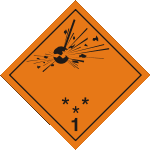 Explosives Explosives |
- Division 1.1: Substances and articles which have a mass explosion hazard
- Division 1.2: Substances and articles which have a projection hazard but not a mass explosion hazard
- Division 1.3: Substances and articles which have a fire hazard and either a minor blast hazard or a minor projection hazard or both, but not a mass explosion hazard
|
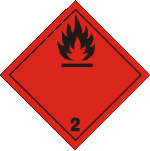 Flammable Gases Flammable Gases |
- Gases which at 20 °C and a standard pressure of 101.3 kPa:
- -are ignitable when in a mixture of 13 per cent or less by volume with air; or
- -have a flammable range with air of at least 12 percentage points regardless of the lower flammable limit.
|
 Non-flammable Non-toxic Gases Non-flammable Non-toxic Gases |
- Gases which:
- are asphyxiant - gases which dilute or replace the oxygen normally in the atmosphere; or
- are oxidizing - gases which may, generally by providing oxygen, cause or contribute to the combustion of other material more than air does; or
- do not come under the other divisions
|
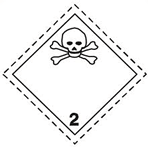 Toxic Gases Toxic Gases |
- Gases which:
- are known to be so toxic or corrosive to humans as to pose a hazard to health; or
- are presumed to be toxic or corrosive to humans because they have an LC50 value equal to or less than 5000 ml/m3 (ppm).
|
 Flammable Liquids Flammable Liquids |
- Liquids which have a flash point of less than 60 °C and which are capable of sustaining combustion
|
 Flammable Solids self-reactive substances and solid desensitized explosives Flammable Solids self-reactive substances and solid desensitized explosives |
- Solids which, under conditions encountered in transport, are readily combustible or may cause or contribute to fire through friction; self-reactive substances which are liable to undergo a strongly exothermic reaction; solid desensitized explosives which may explode if not diluted sufficiently
|
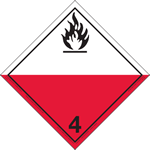 Substances Liable to Spontaneous Combustion Substances Liable to Spontaneous Combustion |
- Substances which are liable to spontaneous heating under normal conditions encountered in transport, or to heating up in contact with air, and being then liable to catch fire
|
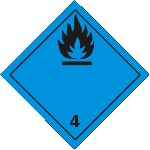 Substances which in contact with water emit flammable gases Substances which in contact with water emit flammable gases |
- Substances which, by interaction with water, are liable to become spontaneously flammable or to give off flammable gases in dangerous quantities
|
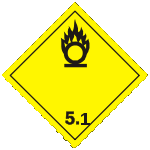 Oxidizing Substances Oxidizing Substances |
- Substances which, while in themselves not necessarily combustible, may, generally by yielding oxygen, cause, or contribute to, the combustion of other material
|
 Organic Peroxides Organic Peroxides |
- Organic substances which contain the bivalent -O-O- structure and may be considered derivatives of hydrogen peroxide, where one or both of the hydrogen atoms have been replaced by organic radicals
|
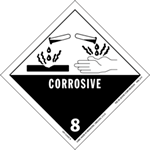 Corrosive Substances Corrosive Substances |
- Substances which:
- cause full thickness destruction of intact skin tissue on exposure time of less than 4 hours; or
- exhibit a corrosion rate of more than 6.25 mm per year on either steel or aluminium surfaces at 55 °C
|
 Exploding Bomb: GHS01
Exploding Bomb: GHS01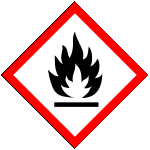 Flame: GHS02
Flame: GHS02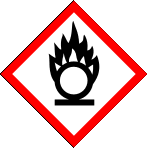 Flame Over Circle: GHS03
Flame Over Circle: GHS03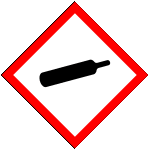 Gas Cylinder: GHS04
Gas Cylinder: GHS04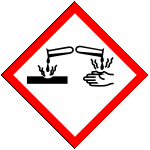 Corrosion: GHS05
Corrosion: GHS05 Skull and Crossbones: GHS06
Skull and Crossbones: GHS06 Exclamation Mark: GHS07
Exclamation Mark: GHS07 Health Hazard: GHS08
Health Hazard: GHS08 Hazardous to the Environment: GHS09
Hazardous to the Environment: GHS09 Explosives
Explosives Flammable Gases
Flammable Gases Non-flammable Non-toxic Gases
Non-flammable Non-toxic Gases Toxic Gases
Toxic Gases Flammable Liquids
Flammable Liquids Flammable Solids self-reactive substances and solid desensitized explosives
Flammable Solids self-reactive substances and solid desensitized explosives Substances Liable to Spontaneous Combustion
Substances Liable to Spontaneous Combustion Substances which in contact with water emit flammable gases
Substances which in contact with water emit flammable gases Oxidizing Substances
Oxidizing Substances Organic Peroxides
Organic Peroxides Corrosive Substances
Corrosive Substances B - Biohazard
B - Biohazard C - Corrosive
C - Corrosive E - Explosive
E - Explosive F - Flammable
F+ - Extremely Flammable
F - Flammable
F+ - Extremely Flammable Xi - Irritant
Xn - Harmful
Xi - Irritant
Xn - Harmful N - Dangerous for the Environment
N - Dangerous for the Environment O - Oxidizing
O - Oxidizing R - Radioactive
R - Radioactive T - Toxic
T - Toxic